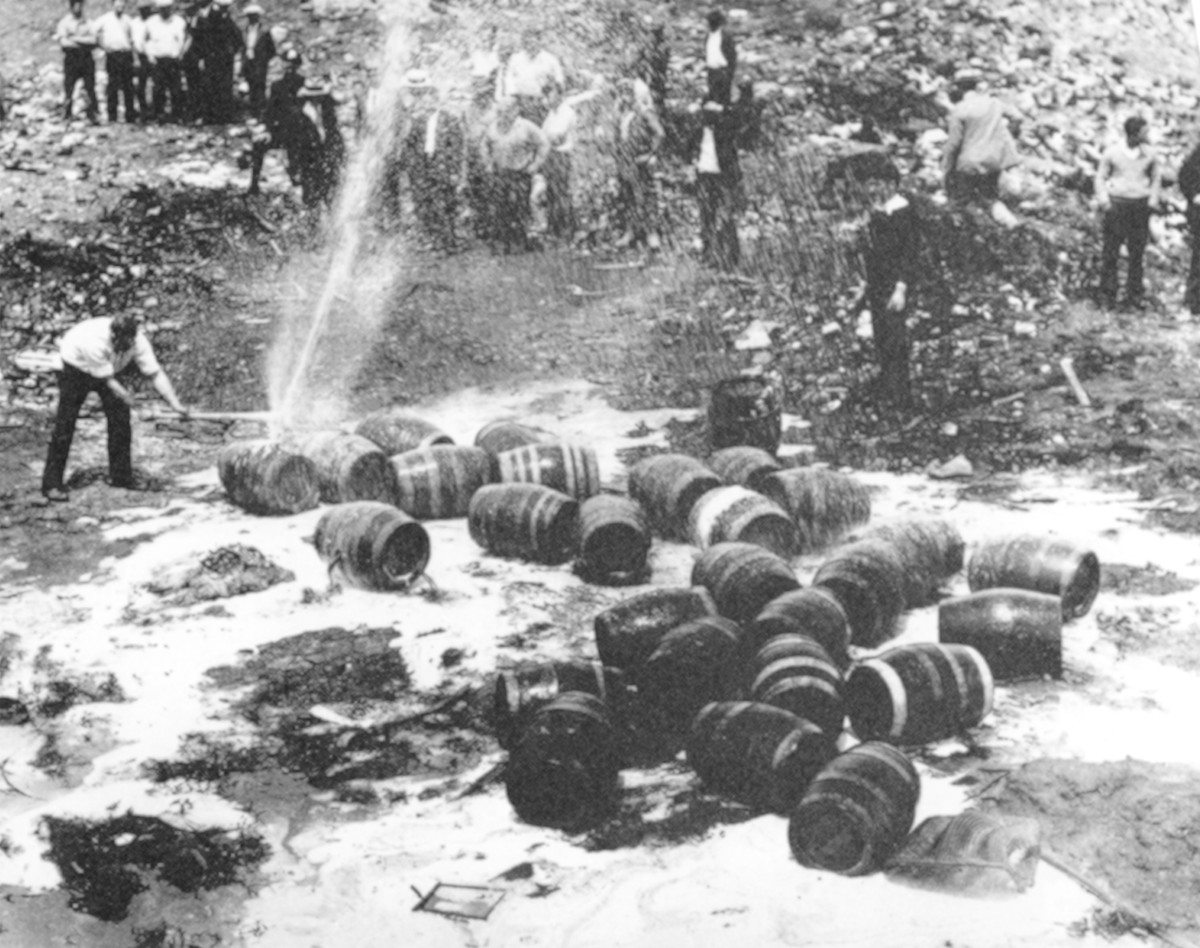
In this June 18, 1931, file photo beer barrels are destroyed by prohibition agents at a dump in New York City. The federal government, as well as state and local authorities, spent huge sums on enforcement yet never allocated sufficient resources to do the job effectively. Bootleggers awash in cash bribed judges, politicians and law enforcement officers to let their operations continue. (AP Photo, File)
NEW YORK (AP) - In this era of bottomless mimosas, craft beers and ever-present happy hours, it's striking to recall that 100 years ago the United States imposed a nationwide ban on the production and sale of all types of alcohol.
The Prohibition Era, which lasted from Jan. 17, 1920, until December 1933, is now viewed as a failed experiment that glamorized illegal drinking, but there are several intriguing parallels in current times.
Americans are consuming more alcohol per capita now than in the time leading up to Prohibition, when alcohol opponents successfully made the case that excessive drinking was ruining family life. More states are also moving to decriminalize marijuana, with legalization backers frequently citing Prohibition's failures. Many of the same speakeasy locations operating in the 1920s are flourishing in a culture that romanticizes the era.
And in a time of heightened racial divisions, Prohibition offers a poignant history lesson on how the restrictions targeted blacks and recent immigrants more harshly than other communities. That treatment eventually propelled many of those marginalized Americans into the Democratic Party, which engineered Prohibition's repeal.
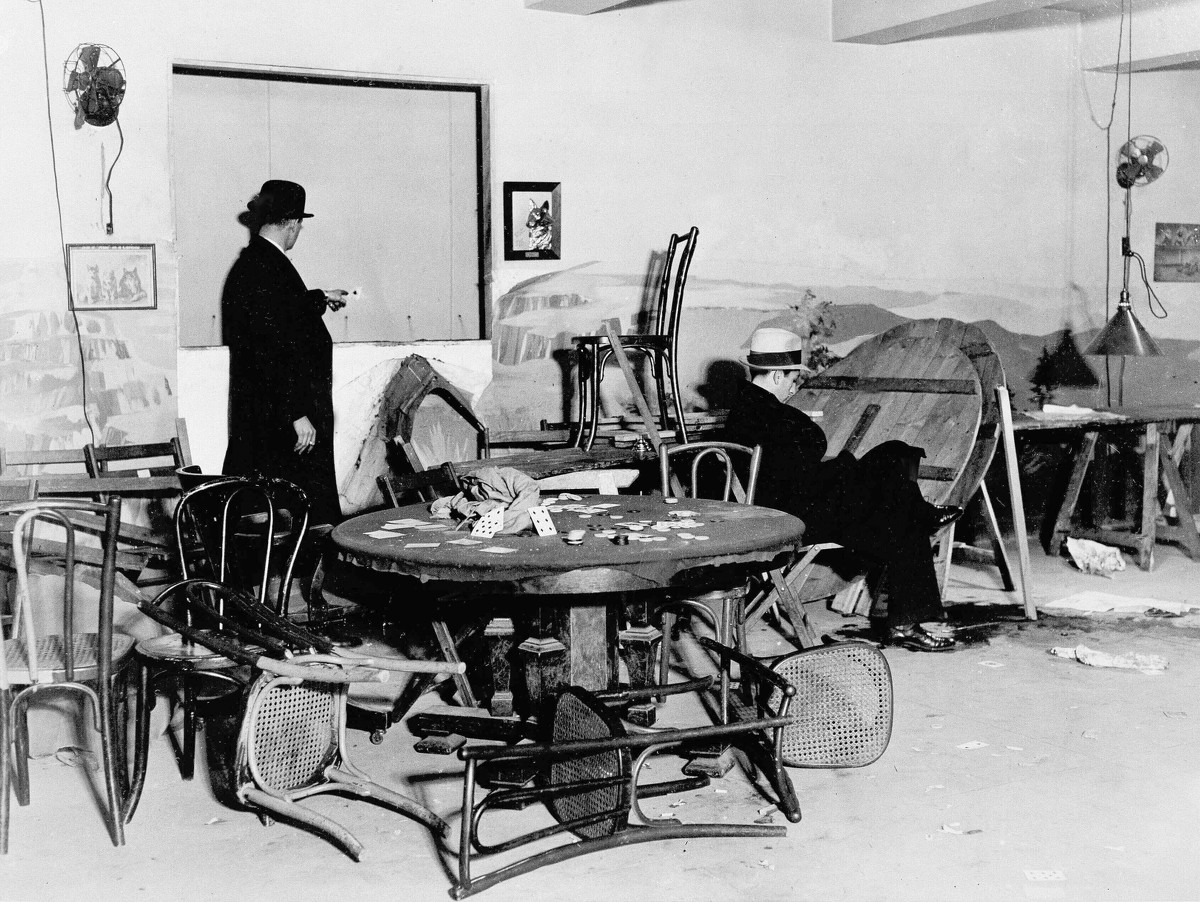
In this Dec. 31, 1931, file photo the wrecked speakeasy in the Hotel Victoria in mid-Manhattan, where Louis Levine, alias Louis Taylor, a small-time gambler, was killed by one of three gunmen earlier in the day in New York. A bystander points to a bullet hole in the wall, while another is seated in the chair where Levine, known as "Crooked Neck Louie", was gambling when he was shot. (AP Photo, File)
"Prohibition had a lot of unintended consequences that backfired on the people who worked so hard to establish the law," said Harvard history professor Lisa McGirr, whose 2015 book "The War on Alcohol" examines Prohibition's political and social repercussions.
"It helped to activate and enfranchise men and women who had not been part of the political process earlier," she said. "That was not the intention of Prohibition supporters."
Ratification of the 18th Amendment in 1919, which set the stage for Prohibition's launch a year later, culminated a century of advocacy by the temperance movement. Leading forces included the Women's Christian Temperance Union, the Anti-Saloon League and many Protestant denominations. Prohibition supporters assailed the impact of booze on families and the prominent role that saloons played in immigrant communities.
Prohibition greatly expanded federal law enforcement powers and turned millions of Americans into scofflaws. It provided a new revenue stream for organized crime.
By the time the constitutional amendment was ratified in January 1919, many states had enacted their own prohibition laws. That October, Congress passed a law detailing how the federal government would enforce Prohibition. It was known as the Volstead Act in recognition of its foremost champion, Rep. Andrew Volstead of Minnesota. The law banned the manufacture, sale and transport of any "intoxicating liquor" - beverages with an alcohol content of more than 0.5%, including beer and wine.
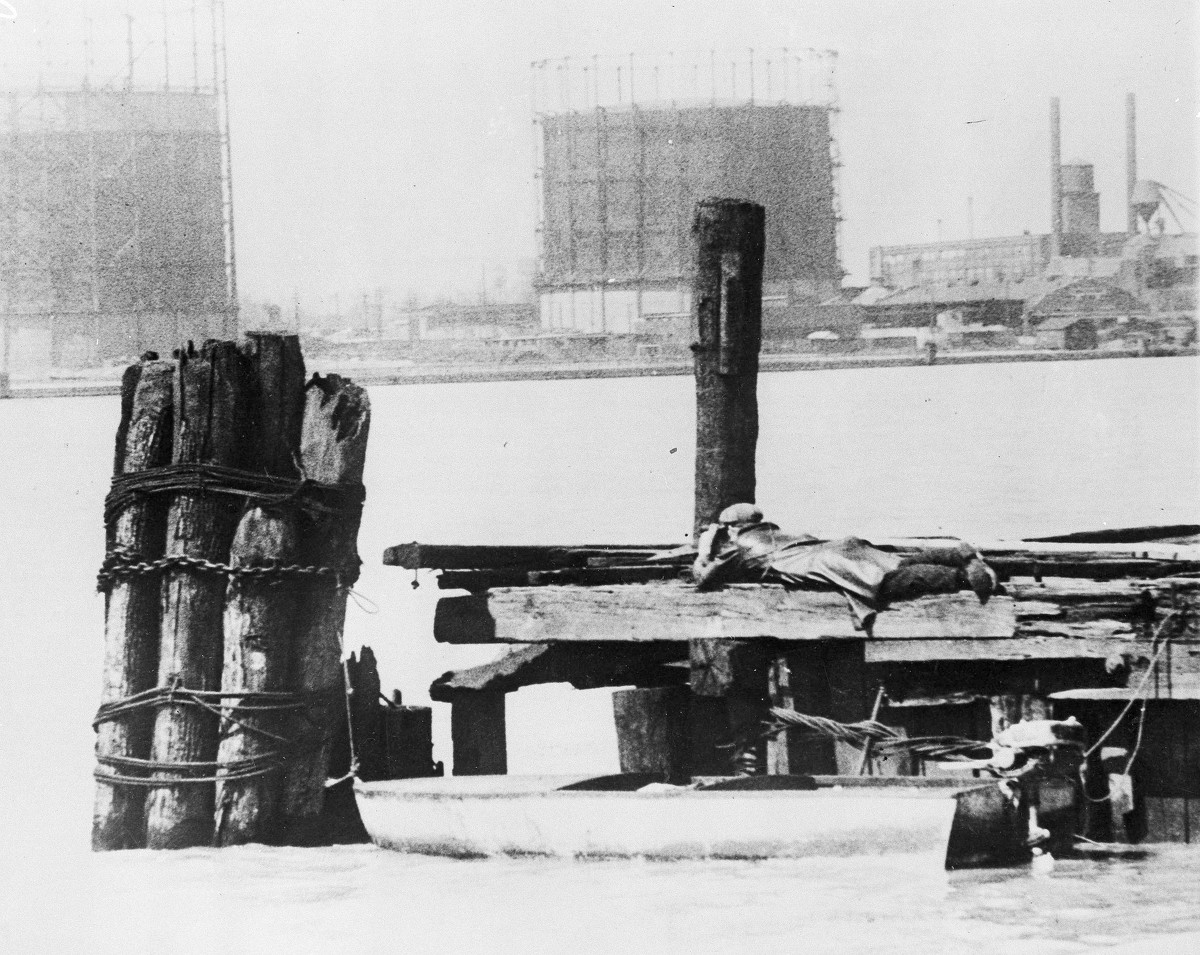
In this April 28, 1929, file photo a rum runner in Windsor, on the Canadian side of the Detroit River, watches with field glasses for lookout on the American side to signal that no prohibition agents are in sight. His outboard motorboat, loaded with illegal liquor, is shown beneath pilings. (AP Photo, File)
Statistically, Prohibition was not an utter failure. Deaths from alcohol-related cirrhosis declined, as did arrests for public drunkenness.
What the statistics don't measure is how extensively Prohibition was flouted. Bootleggers established vast distribution networks. Makers of moonshine and "bathtub gin" proliferated, sometimes producing fatally tainted liquor. Determined drinkers concealed their contraband in hip flasks or hollowed-out canes. Maryland refused to pass a law enforcing the Volstead Act.
McSorley's Old Ale House, established in New York in 1854 and still flourishing as one of the city's oldest bars, never closed during Prohibition. Ostensibly, it served "near beer" with permissibly low alcohol content, but in fact produced a strong ale from a makeshift brewery erected in the basement.
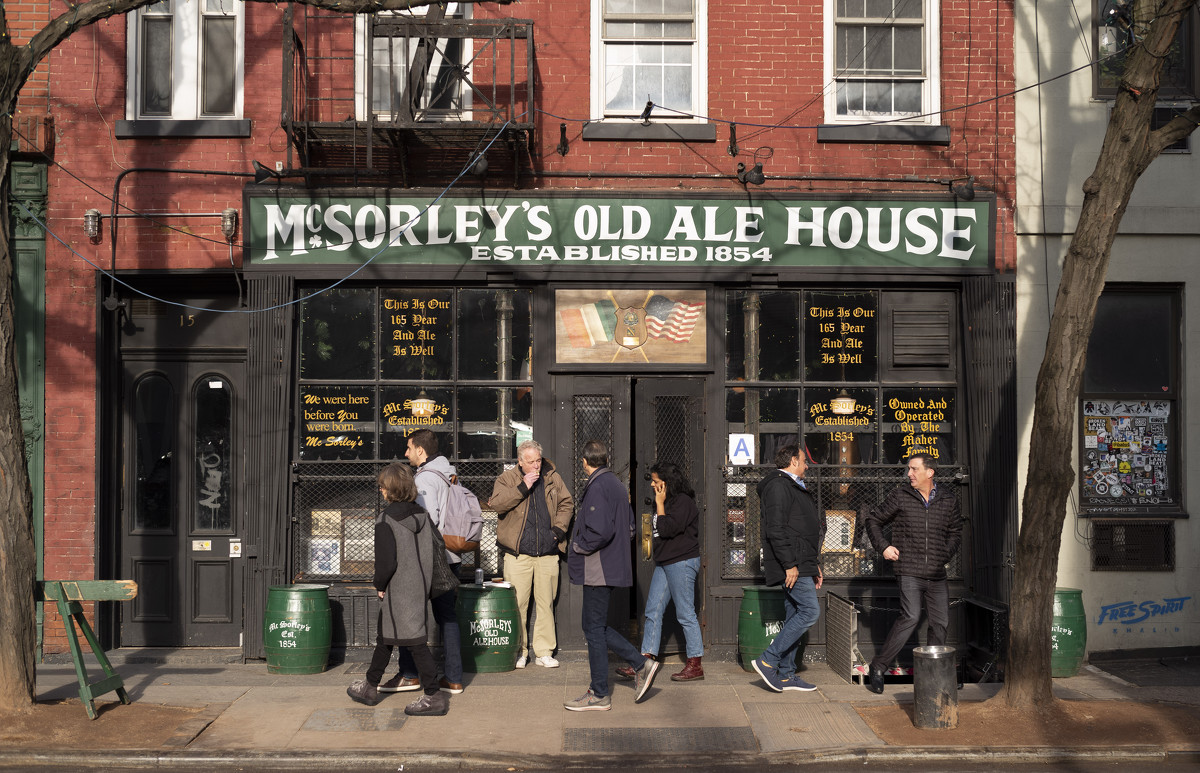
In this Dec. 27, 2019 photo, people come and go from McSorley's Old Ale House in New York. Located in Manhattan's Lower East Side, McSorley's opened in the mid-19th century, functioned as a speakeasy during Prohibition, and continues in operation today. (AP Photo/Mark Lennihan)
"It wasn't a near beer. It was McSorley's ale," said the pub's manager, Gregory de la Haba. "At least once a week, people ask, 'What did we do during Prohibition?' And my reply, 'We made a ton of money.'''
The federal government, as well as state and local authorities, spent huge sums on enforcement yet never allocated sufficient resources to do the job effectively. Bootleggers awash in cash bribed judges, politicians and law enforcement officers to let their operations continue.
"Newly hired and poorly trained Prohibition agents, along with local and state police, targeted violators at the margins," McGirr wrote in a recent article. "But they lacked the capacity, and at times the will, to go after powerful crime kingpins."
It's simplistic to say Prohibition created organized crime in America, but it fueled a huge expansion as local crime gangs collaborated with those from other regions to establish shipping systems and set prices for bootlegged alcohol. Beneficiaries included Chicago-based gangster Al Capone, who earned tens of millions of dollars annually from bootlegging and speakeasies. In the infamous St. Valentine's Day Massacre of 1929, gunmen disguised as police officers killed seven men from a gang that sought to compete with Capone's empire.
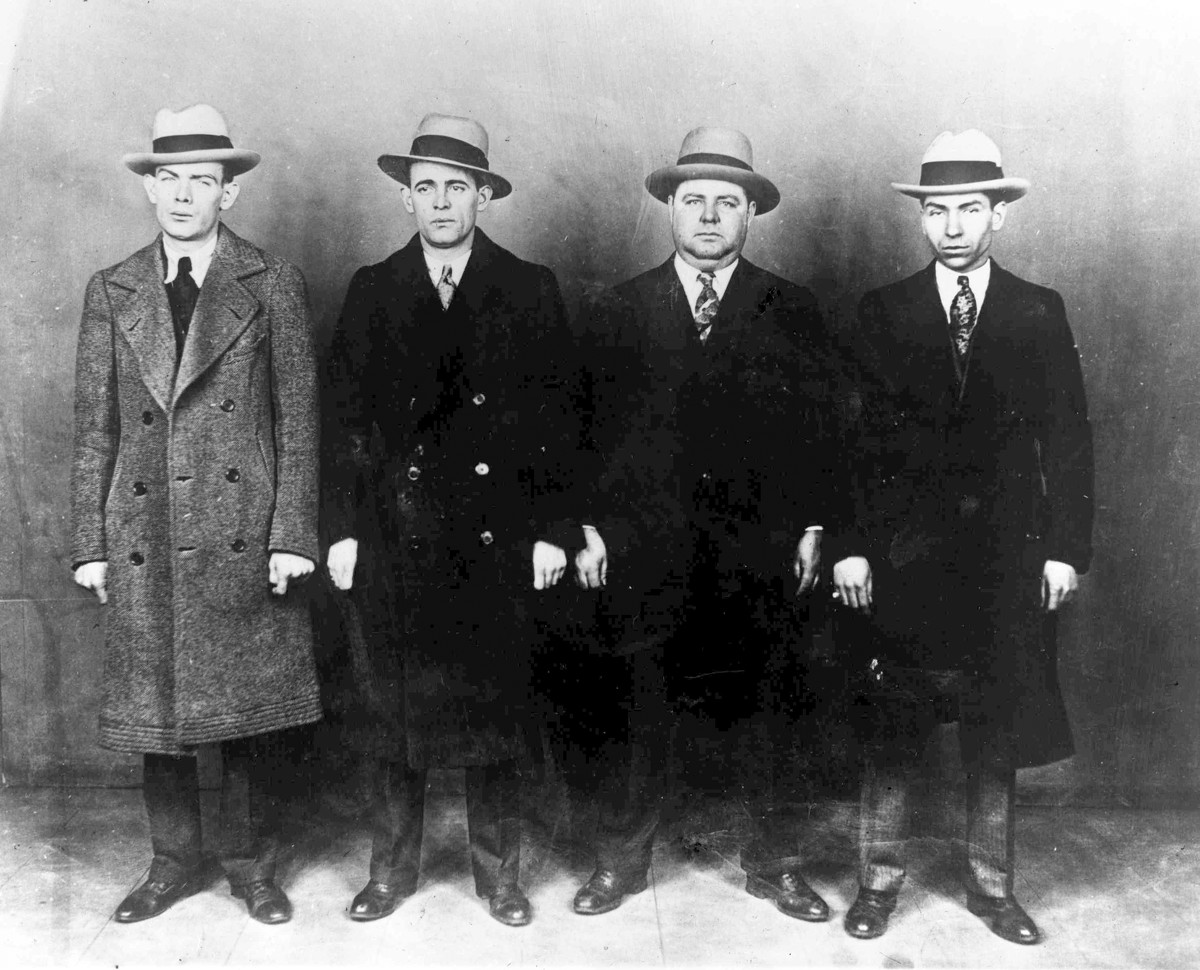
In this Oct. 20, 1930, file photo from left, gangsters Ed Diamond, Jack Diamond, Fatty Walsh and Charles "Lucky" Luciano pose for a photo in New York. It's simplistic to say Prohibition created organized crime in America, but it fueled a huge expansion as local crime gangs collaborated with those from other regions to establish shipping systems and set prices for bootlegged alcohol. (AP Photo, File)
Beyond the ranks of gangsters, legions of Americans were committing or abetting crime. Michael Lerner, in his book "Dry Manhattan: Prohibition in New York City," says courtrooms and jails were so overwhelmed that judges began accepting plea bargains, "making it a common practice in American jurisprudence for the first time."
Anti-immigrant sentiment was a key factor behind Prohibition, partly because of record-high immigration in the preceding decades.
Saloons in immigrant neighborhoods were prime targets, says Slippery Rock University history professor Aaron Cowan, because middle-class white Protestants viewed them as political and social danger zones.
"Often the political machines run by the bosses were based in these saloons, or used them as a conduit for extending favors," Cowan said. "So there was concern about political corruption, changing social values, immigrants learning radical politics."
Prohibition's start in 1920 coincided with a major expansion of the Ku Klux Klan, which supported the ban on alcohol as it waged its anti-immigrant, anti-Catholic and racist activities.
The Volstead Act "provided a way for the Klan to legitimize its 100% Americanist mission - it could target the drinking of those they perceived to be their enemies," McGirr said.
One notorious example occurred in 1923-24 in southern Illinois' Williamson County, where the Klan mobilized hundreds of volunteers to raid saloons and roadhouses. Hundreds of people were arrested and more than a dozen killed.
That kind of social friction helped spur efforts to repeal Prohibition. Economics also played a role.

In this 1910 file photo temperance leader Carrie Nation wields her hatchet and bible in 1910. Nation has destroyed more than a few saloons with her hatchet. Ratification of the 18th Amendment in 1919, which set the stage for Prohibition's launch a year later, culminated a century of advocacy by the temperance movement. Leading forces included the Women's Christian Temperance Union, the Anti-Saloon League and many Protestant denominations. (AP Photo, File)
While some Prohibition supporters predicted it would boost the economy, instead it proved harmful. Thousands of jobs were lost due to closures of distilleries, breweries and saloons. Federal, state and local governments lost billions in revenue as liquor taxes disappeared. One major consequence: Increasing reliance on income taxes to sustain government spending.
The onset of the Great Depression hastened Prohibition's demise, as the need for more jobs and tax revenue became acute. The Democratic Party called for repeal of Prohibition in its 1932 platform; its presidential nominee, Franklin D. Roosevelt, embraced that cause as he rolled to a landslide victory over incumbent Republican Herbert Hoover.
In March 1933, soon after taking office, Roosevelt signed a law legalizing the sale of wine and 3.2% beer. Congress also proposed a 21st Amendment that would repeal the 18th Amendment. Prohibition formally ended that December, when Utah provided the final vote needed to ratify the new amendment.
One of the pithiest summaries of Prohibition came earlier - a scathing assessment from journalist H.L. Mencken in 1925.
Five years of Prohibition "completely disposed of all the favorite arguments of the Prohibitionists," he wrote. "There is not less crime, but more. There is not less insanity, but more. The cost of government is not smaller, but vastly greater. Respect for law has not increased, but diminished."
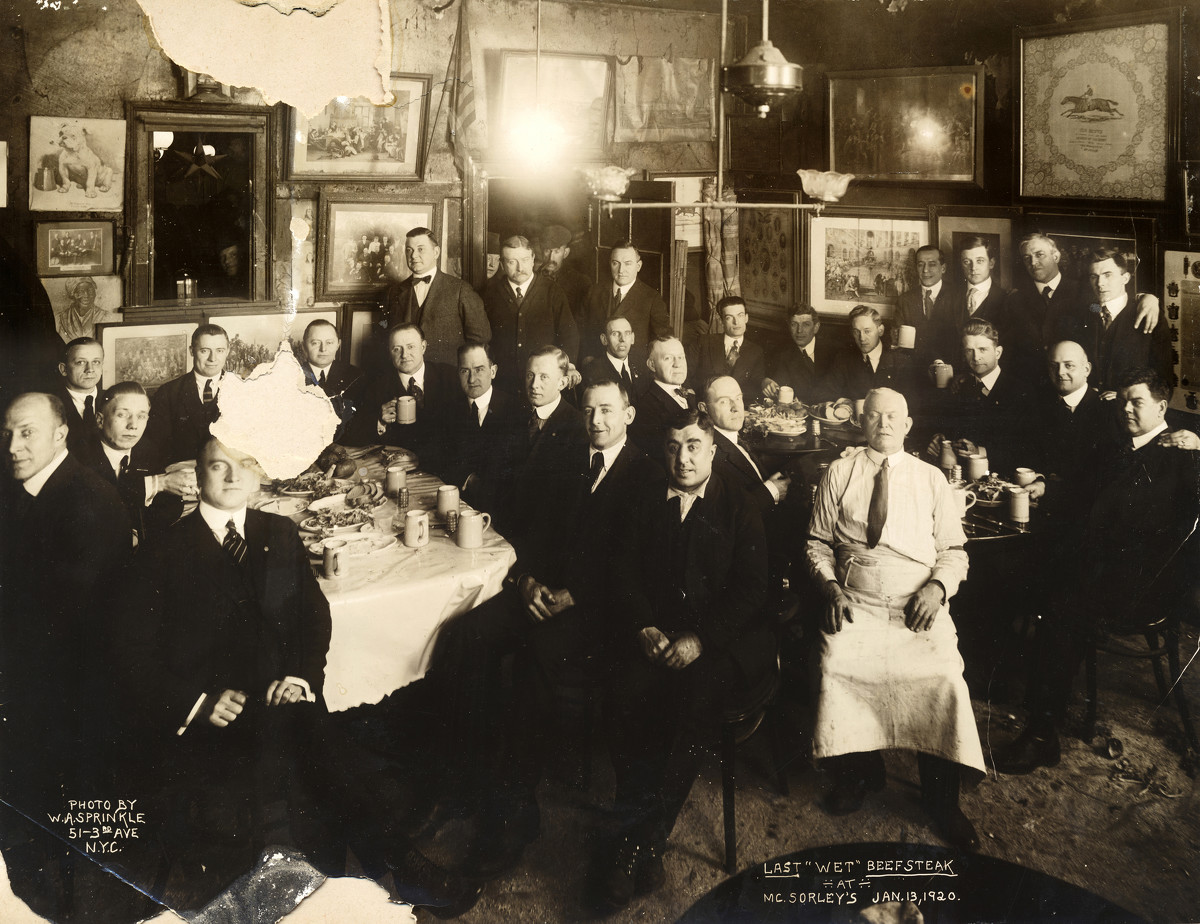
In this Jan. 13, 1920 photo provided by McSorley's Old Ale House, clients and staff pose in the New York bar shortly before the beginning of Prohibition. Located in Manhattan's Lower East Side, McSorley's opened in the mid-19th century, functioned as a speakeasy during Prohibition, and continues in operation today. (W.A. Sprinkle/McSorley's Old Ale House via AP)
Prohibition's centennial comes as the United States is incrementally ending the criminalization of marijuana. Recreational use of pot is now legal in 11 states. More than 30 allow its use for medical purposes.
Marijuana remains illegal under federal law, but Ethan Nadelmann, founder of the pro-legalization Drug Policy Alliance, believes most Americans now view the anti-marijuana crusades of America's "War on Drugs" as misguided in ways that evoke Prohibition.
"Even some of the older generation are saying, 'We went too far. That was a mistake,'" he said.
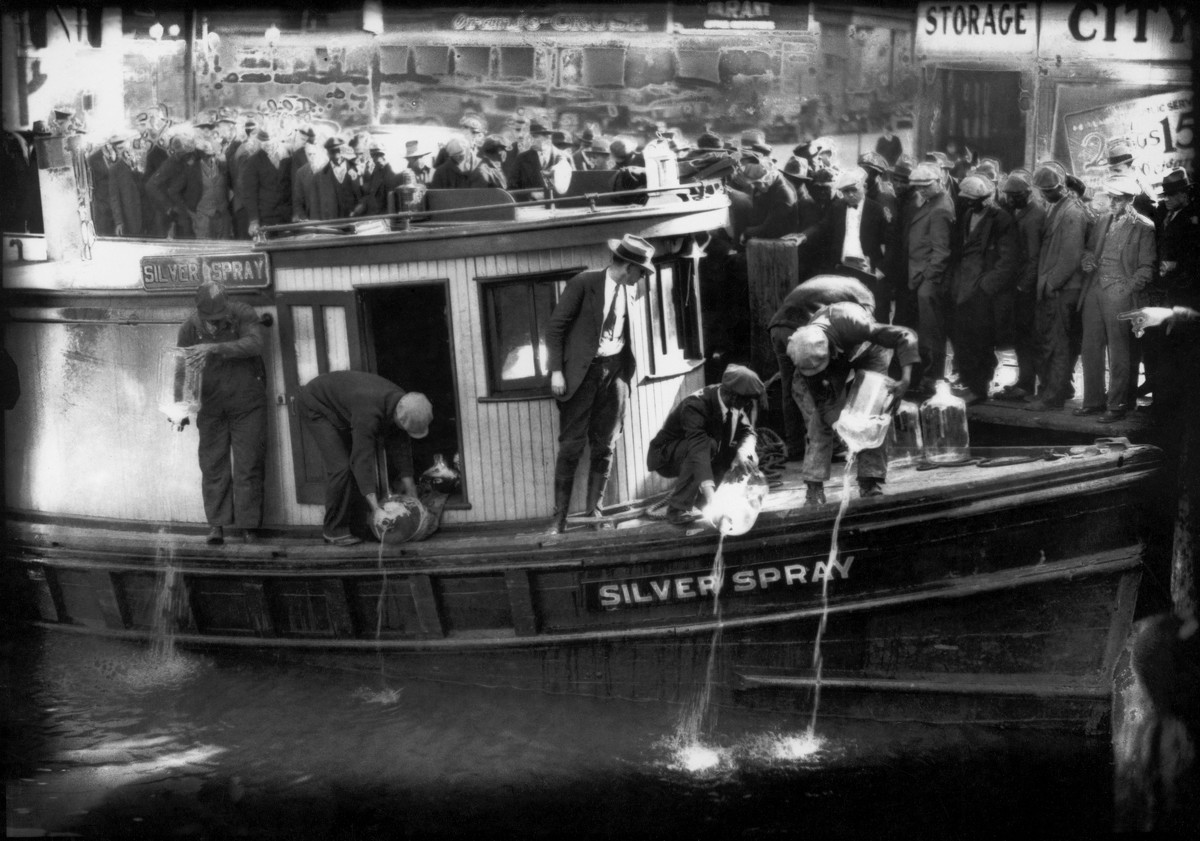
In this 1922 file photo spectators gather by the side of captured rum runner, Silver Spray, as they watch prohibition agents pour "white lightning" from the five-gallon bottles on the deck into the Elizabeth River, Norfolk, Va. The Prohibition Era, which lasted from Jan. 17, 1920, until December 1933, is now viewed as a failed experiment that glamorized illegal drinking. (Charles S. Borjes/The Virginian-Pilot via AP)
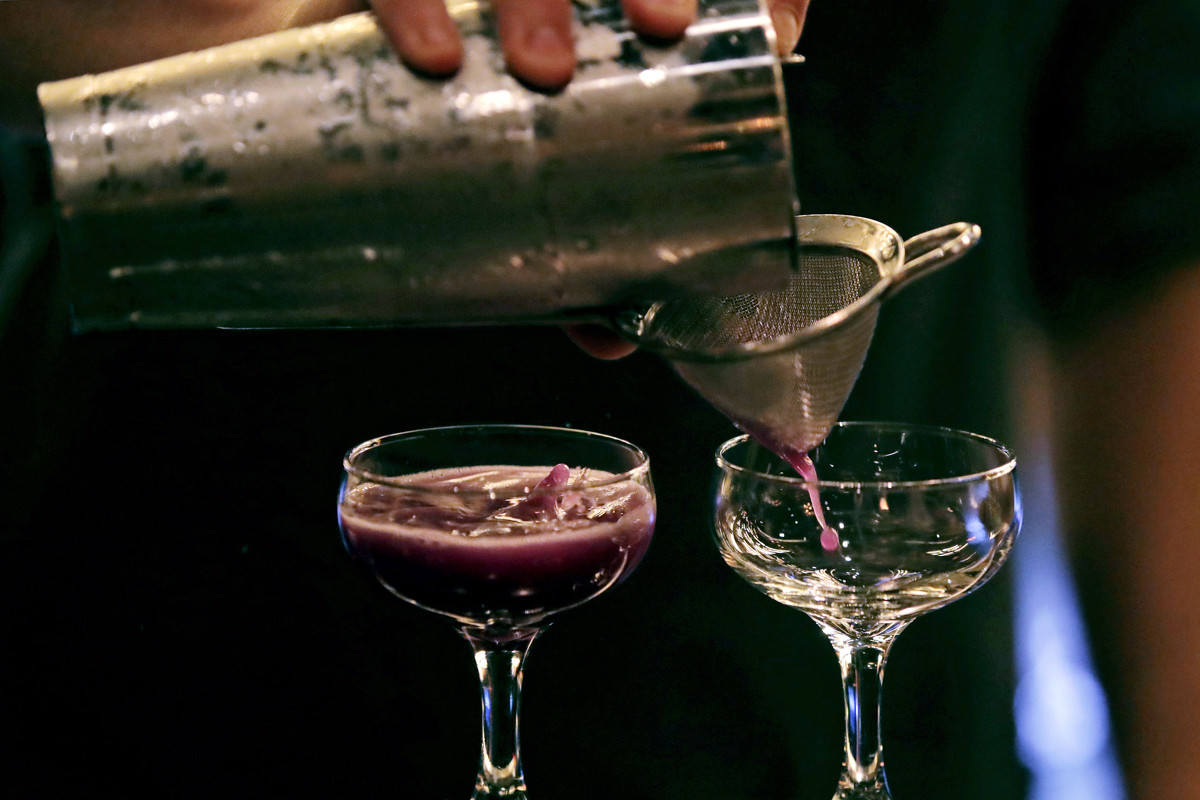
In this Dec. 10, 2019, photo cocktails are crafted at Wink & Nod, basement-dwelling, speakeasy-like bar, in Boston. Americans are consuming more alcohol per capita now than in the time leading up to Prohibition, when alcohol opponents successfully made the case that excessive drinking was ruining family life. (AP Photo/Charles Krupa)
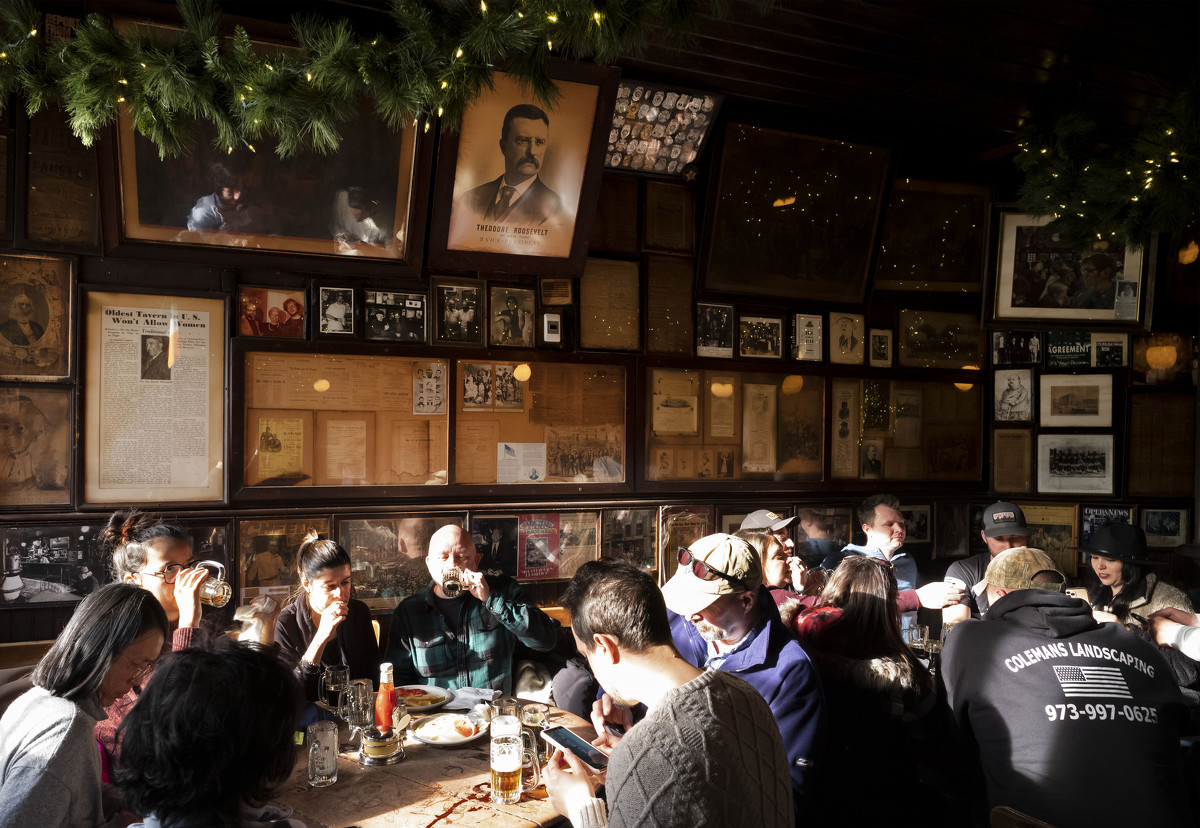
In this Dec. 27, 2019 photo, customers sit beneath vintage photos and documents, including a poster of Vice President Theodore Roosevelt, in McSorley's Old Ale House in New York. Located in Manhattan's Lower East Side, McSorley's opened in the mid-19th century and functioned as a speakeasy during Prohibition. (AP Photo/Mark Lennihan)

In this Feb. 14, 1930, file photo large quantities of Canadian beer and whisky are being transported in cars from Amherstburg, Ont., Canada, across the frozen lower Detroit River, to the Michigan side of the international boundary line. The cars are driven with one door open, so if the car goes through the ice the driver can scramble free. (AP Photo, File)
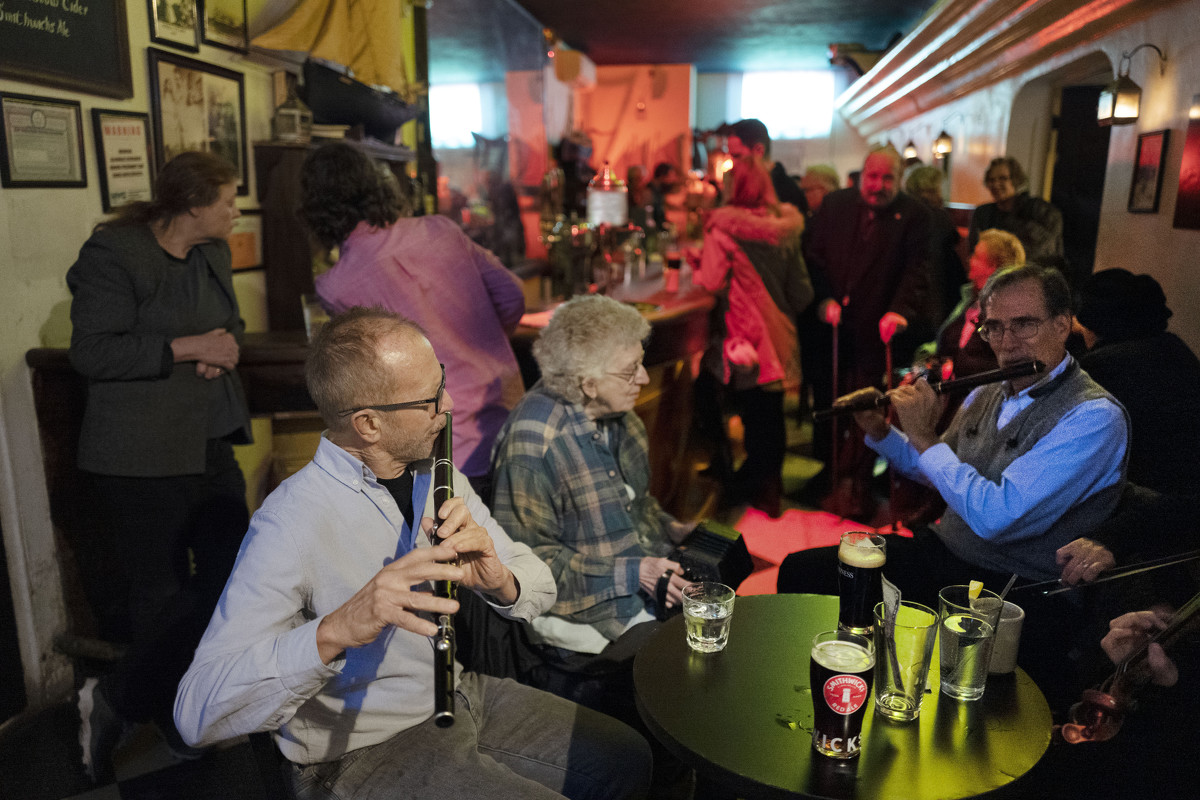
In this Dec. 31, 2019 photo, Richard Heitzman joins with fellow musicians to perform traditional Irish tunes in New York's William Barnacle Tavern, once a speakeasy during Prohibition. Americans are consuming more alcohol per capita now than in the time leading up to Prohibition, when alcohol opponents successfully made the case that excessive drinking was ruining family life. (AP Photo/Mark Lennihan)

In this Dec. 10, 2019, file photo a woman holding an umbrella passes the Carrie Nation lounge in Boston, titled after the namesake of the woman supporting the temperance movement prior to the 1920 Prohibition ban on alcohol. (AP Photo/Charles Krupa, File)

In this Dec. 10, 2019, photo patrons and mixologists at Wink & Nod, basement-dwelling, speakeasy-like bar, in Boston. Americans are consuming more alcohol per capita now than in the time leading up to Prohibition, when alcohol opponents successfully made the case that excessive drinking was ruining family life. (AP Photo/Charles Krupa)
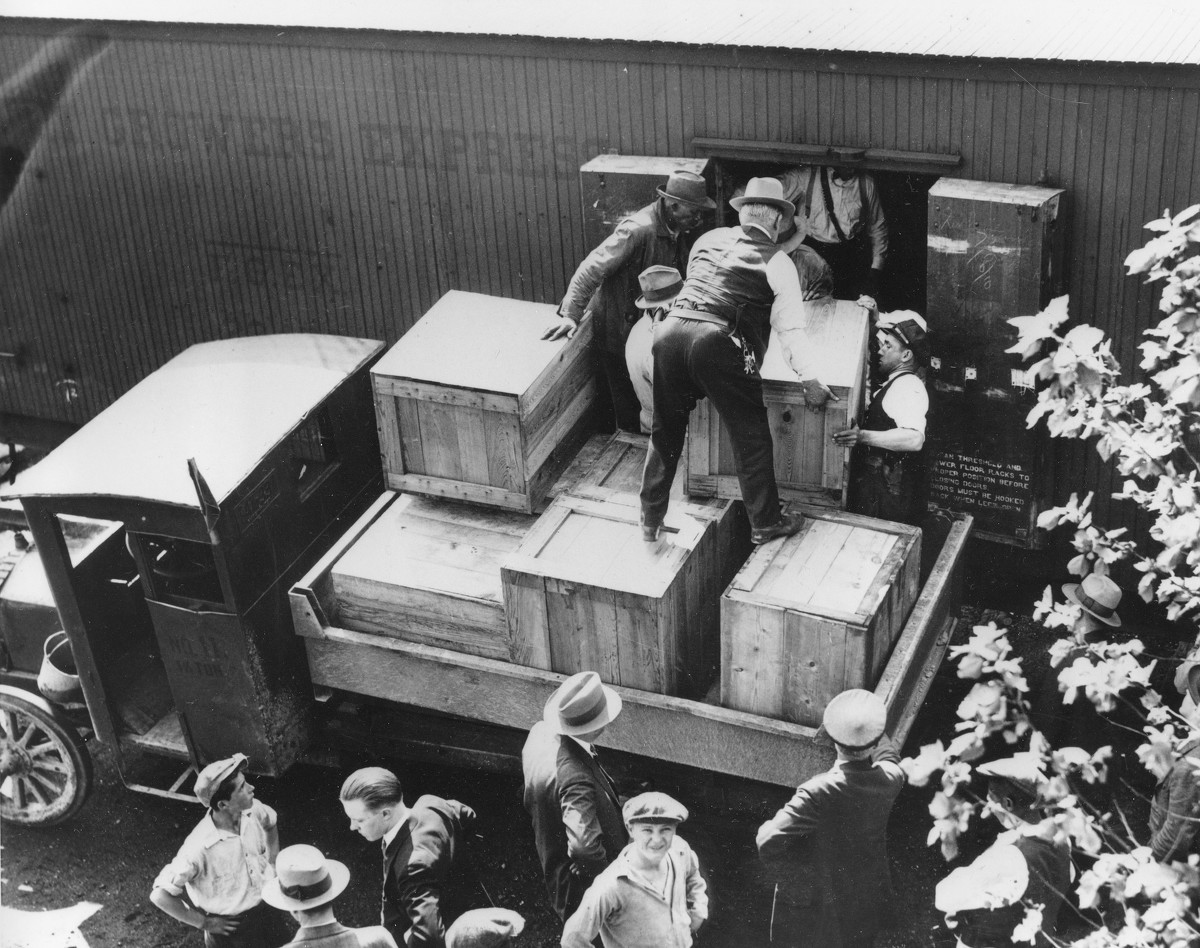
In this May 15, 1929, file photo authorities unload cases of whiskey crates labeled as green tomatoes from a refrigerator car in the Washington yards. The grower's express cargo train was en route from Holandale, Fla., to Newark, N.J. Statistically, Prohibition was not an utter failure. Deaths from alcohol-related cirrhosis declined, as did arrests for public drunkenness. What the statistics don't measure is how extensively Prohibition was flouted. Bootleggers established vast distribution networks. (AP Photo, File)

In this June 12, 1924, file photo bottles of Scotch whiskey smuggled in hollowed-out loaves of bread are pictured, location unknown. Statistically, Prohibition was not an utter failure. Deaths from alcohol-related cirrhosis declined, as did arrests for public drunkenness. What the statistics don't measure is how extensively Prohibition was flouted. Bootleggers established vast distribution networks. (AP Photo, File)
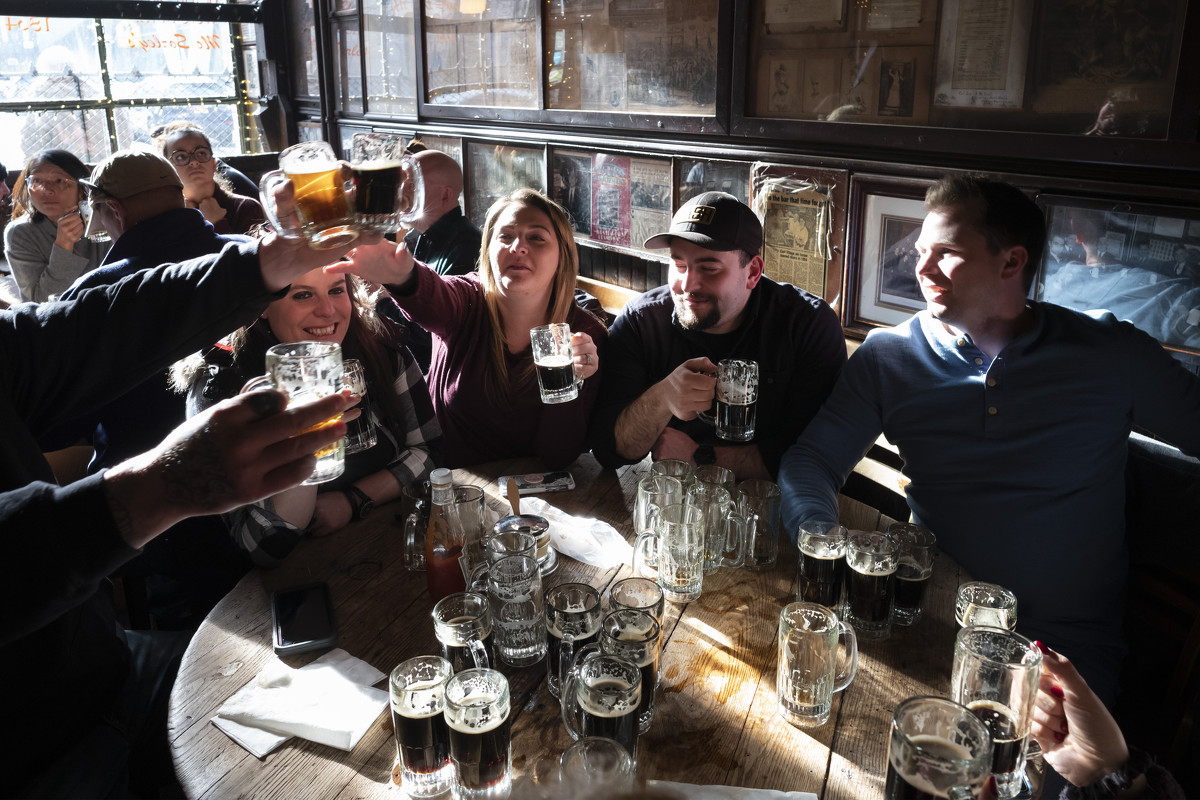
In this Dec. 27, 2019 photo, customers raise their mugs of beer in McSorley's Old Ale House in New York. The Irish bar opened in the mid-19th century and was a speakeasy during Prohibition. Americans are consuming more alcohol per capita now than in the time leading up to Prohibition, when alcohol opponents successfully made the case that excessive drinking was ruining family life. (AP Photo/Mark Lennihan)
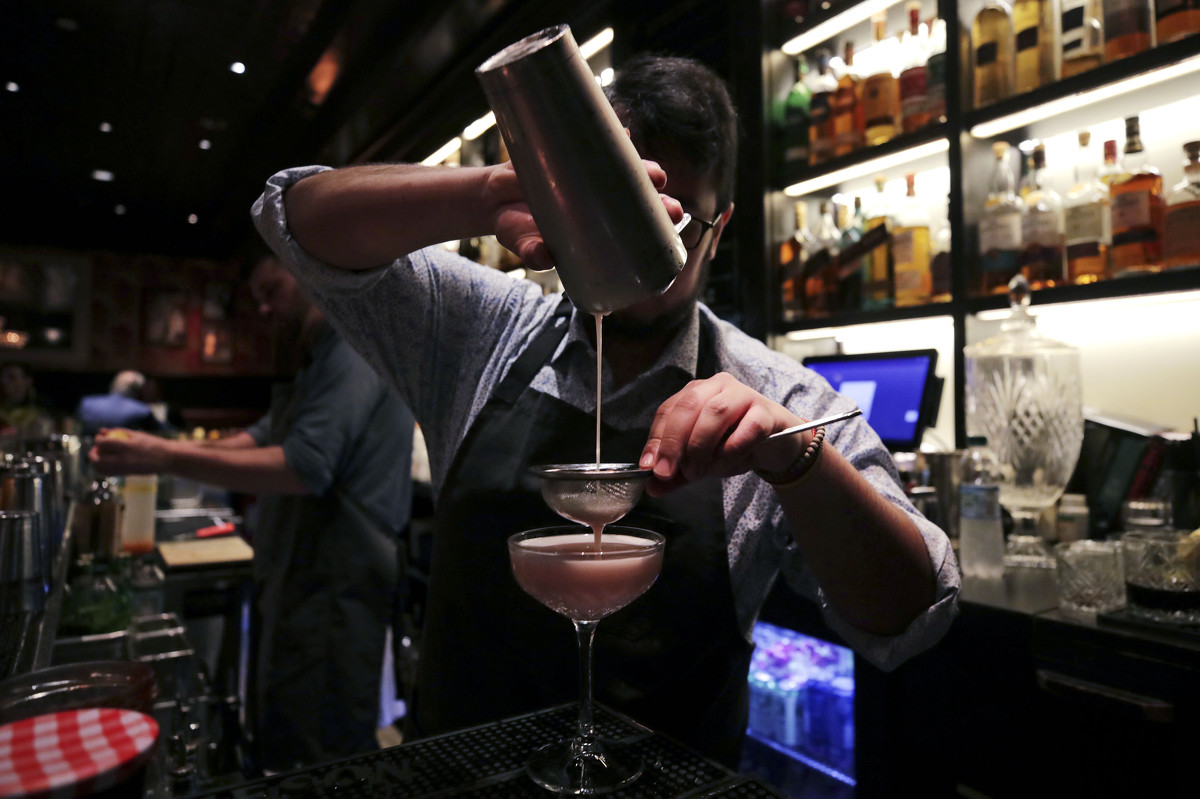
In this Dec. 10, 2019, photo mixologist Julian Bernal crafts a cocktail at Wink & Nod, basement-dwelling, speakeasy-like bar, in Boston. Americans are consuming more alcohol per capita now than in the time leading up to Prohibition, when alcohol opponents successfully made the case that excessive drinking was ruining family life. (AP Photo/Charles Krupa)
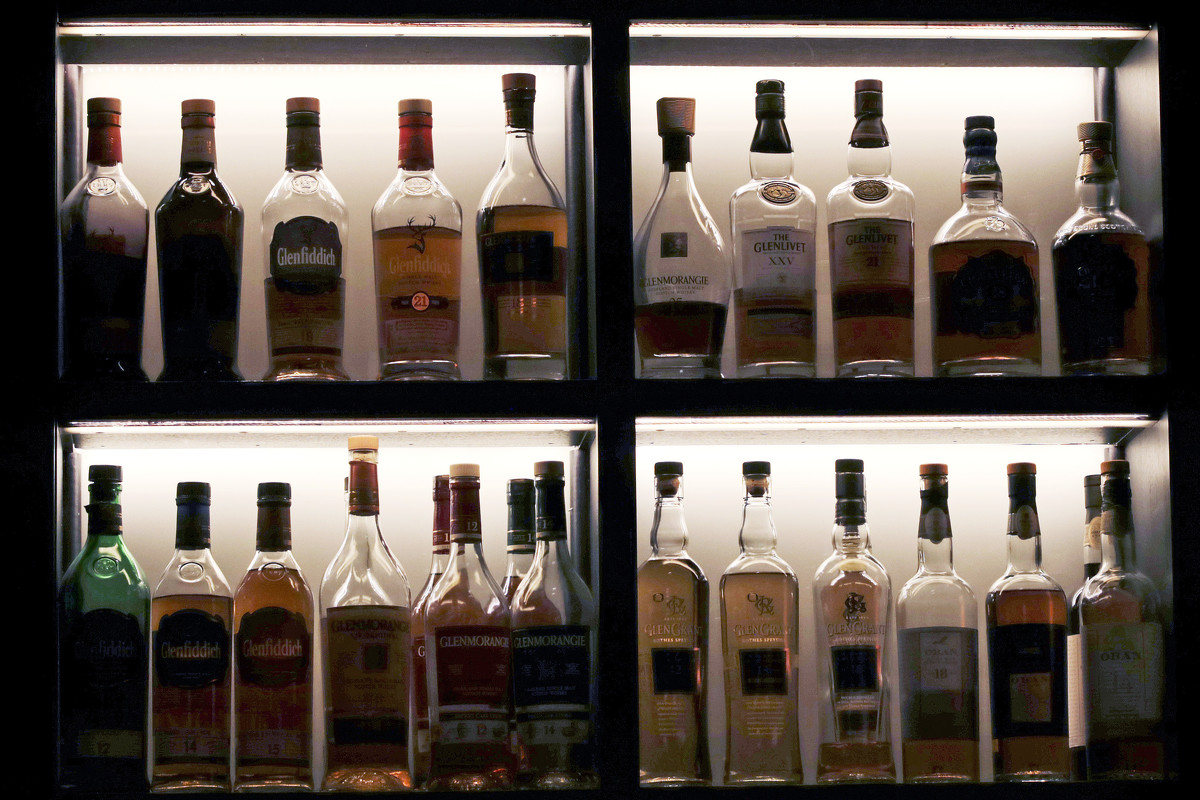
In this Dec. 10, 2019, photo a vast array of fine single malt scotch bottles are displayed at Wink & Nod, basement-dwelling, speakeasy-like bar, in Boston. In this era of bottomless mimosas, craft beers and ever-present happy hours, it's striking to recall that 100 years ago the United States imposed a nationwide ban on the production and sale of all types of alcohol. (AP Photo/Charles Krupa)
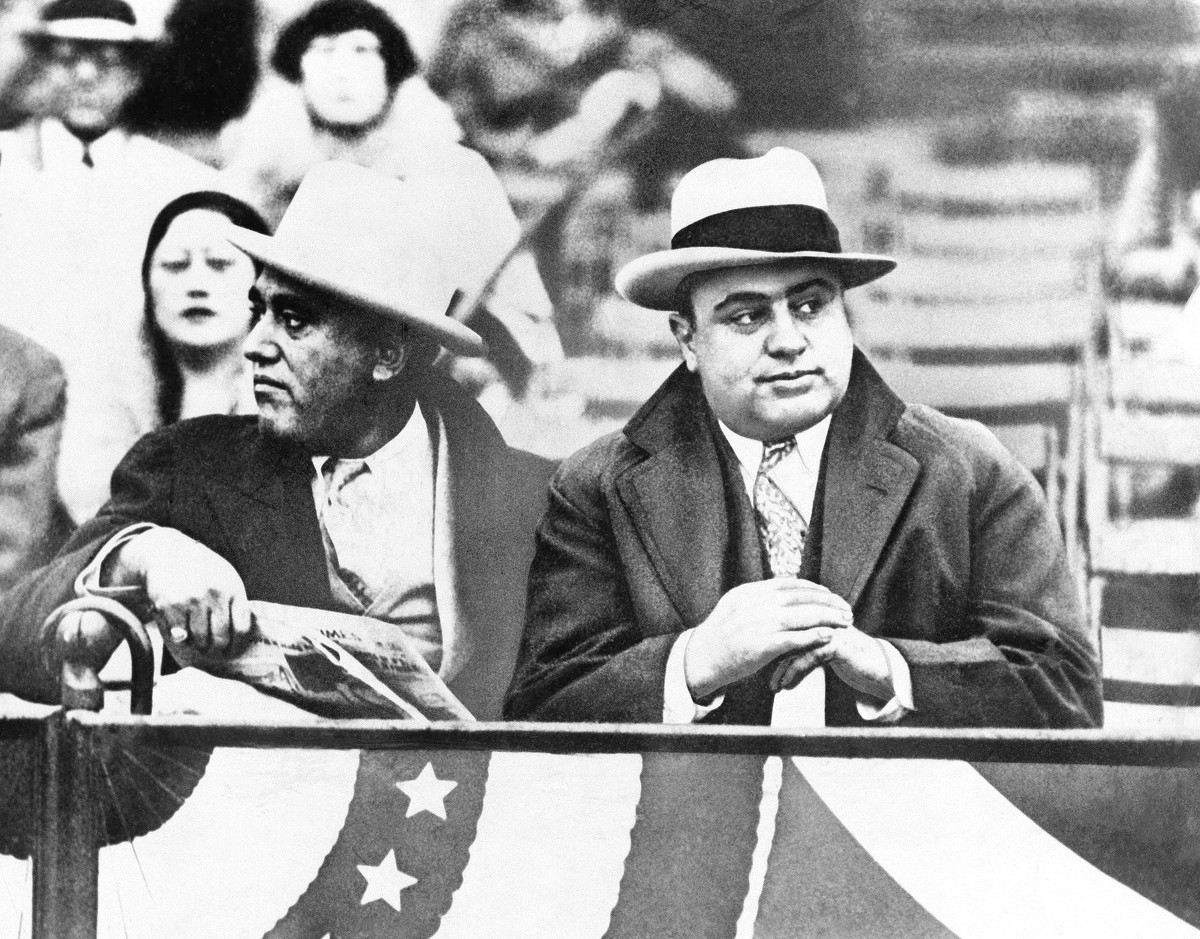
In this Oct. 10, 1931, file photo Al Capone, Chicago gangland, right, attends a game between Notre Dame and Northwestern Grid in Chicago. Former Alderman A.J. Prignano is on the left. Capone earned tens of millions of dollars annually from bootlegging and speakeasies. (AP Photo, File)

In this Jan. 23, 1922, file photo a patrol wagon filled with confiscated moonshine sits next to a wrecked car of bootleggers in Washington. Prohibition greatly expanded federal law enforcement powers and turned millions of Americans into scofflaws. It provided a new revenue stream for organized crime. (AP Photo, File)

In this Dec. 27, 2019 photo, customers mingle in New York's Old Town Bar. Once a speakeasy during Prohibition, the Old Town Bar opened in 1892. In this era of bottomless mimosas, craft beers and ever-present happy hours, it's striking to recall that 100 years ago the United States imposed a nationwide ban on the production and sale of all types of alcohol. (AP Photo/Mark Lennihan)
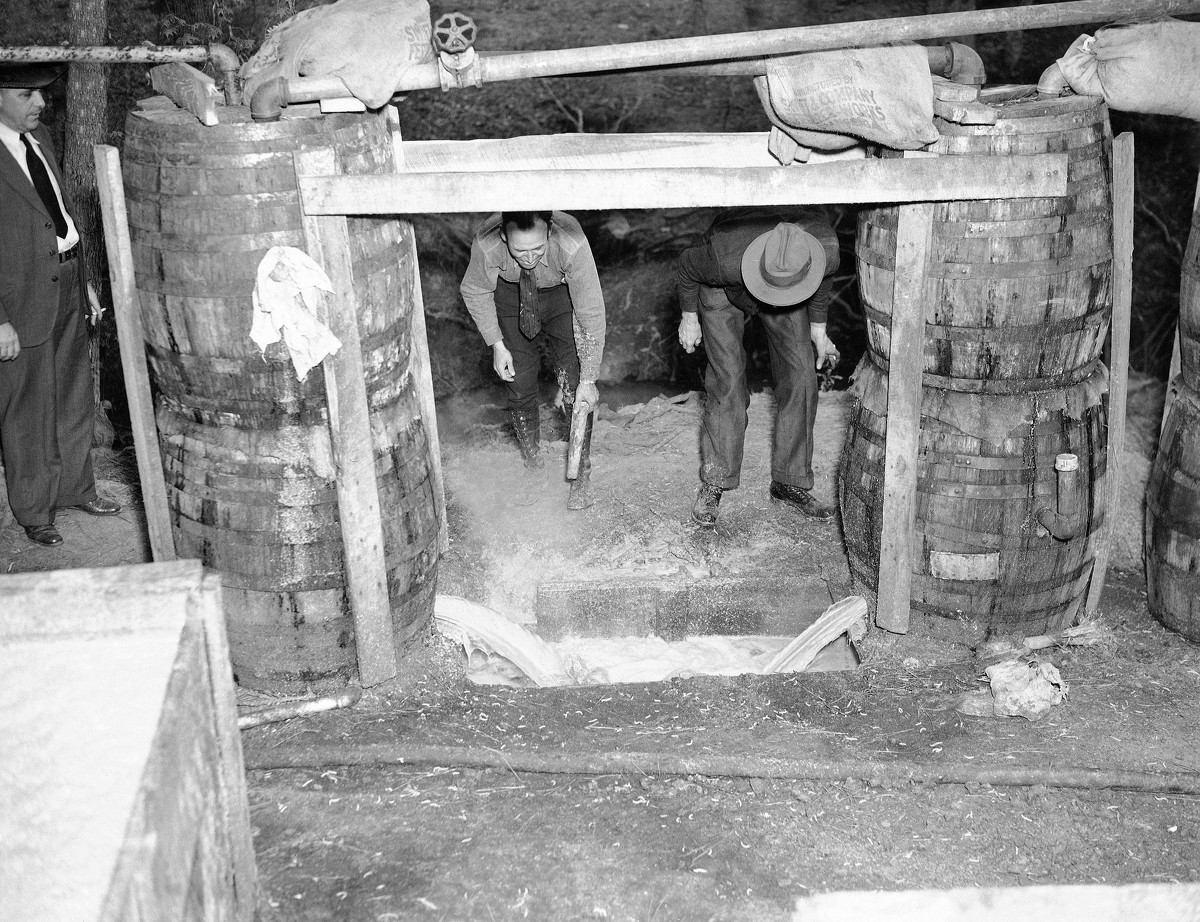
In this May 5, 1937, file photo accompanied by an Associated Press photographer, these federal agents raided this large-scale operation near Griffin, Ga. They then broke up equipment and destroyed materials on hand. (AP Photo/James N. Keen, File)
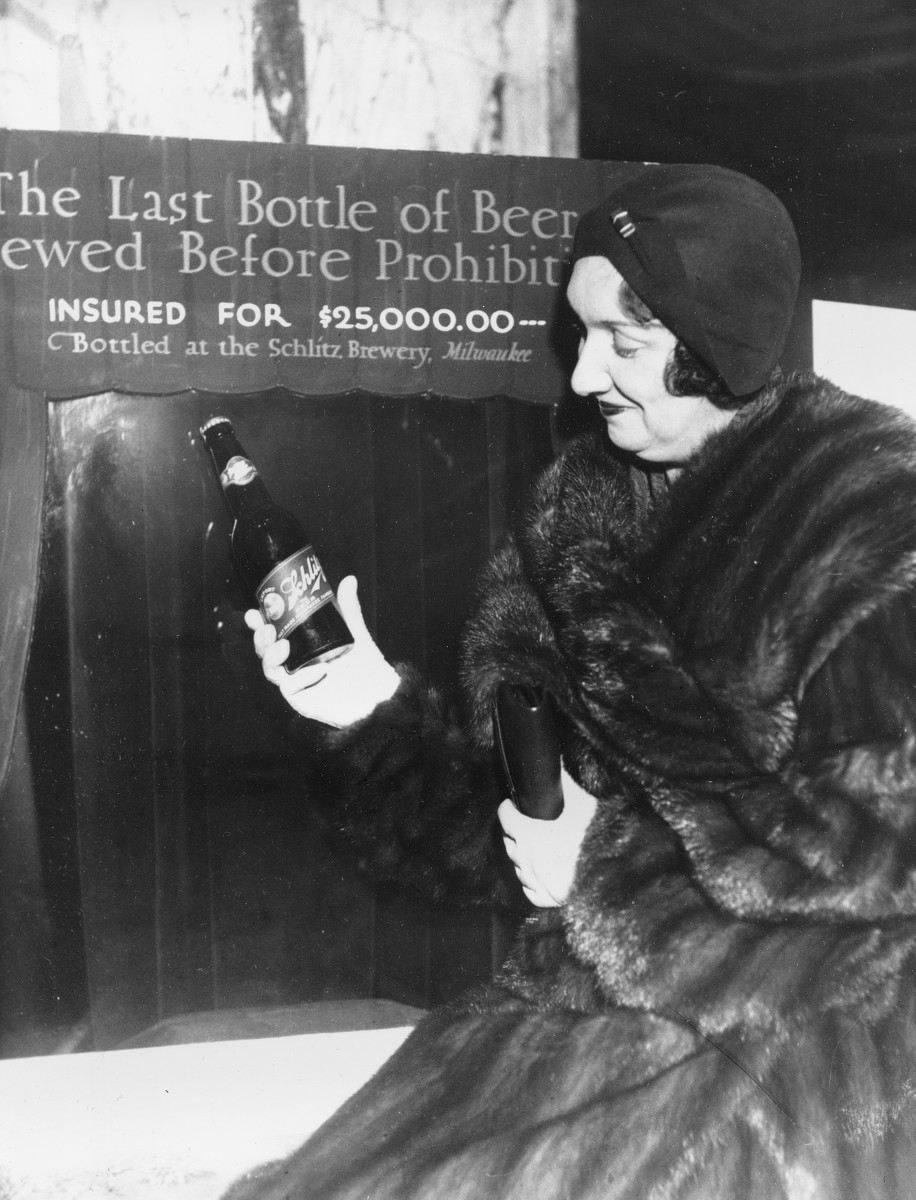
In this Dec. 29, 1930, file photo Rae Samuels holds the last bottle of beer that was distilled before prohibition went into effect in Chicago. The bottle of Schlitz has been insured for $25,000. (AP Photo, File)
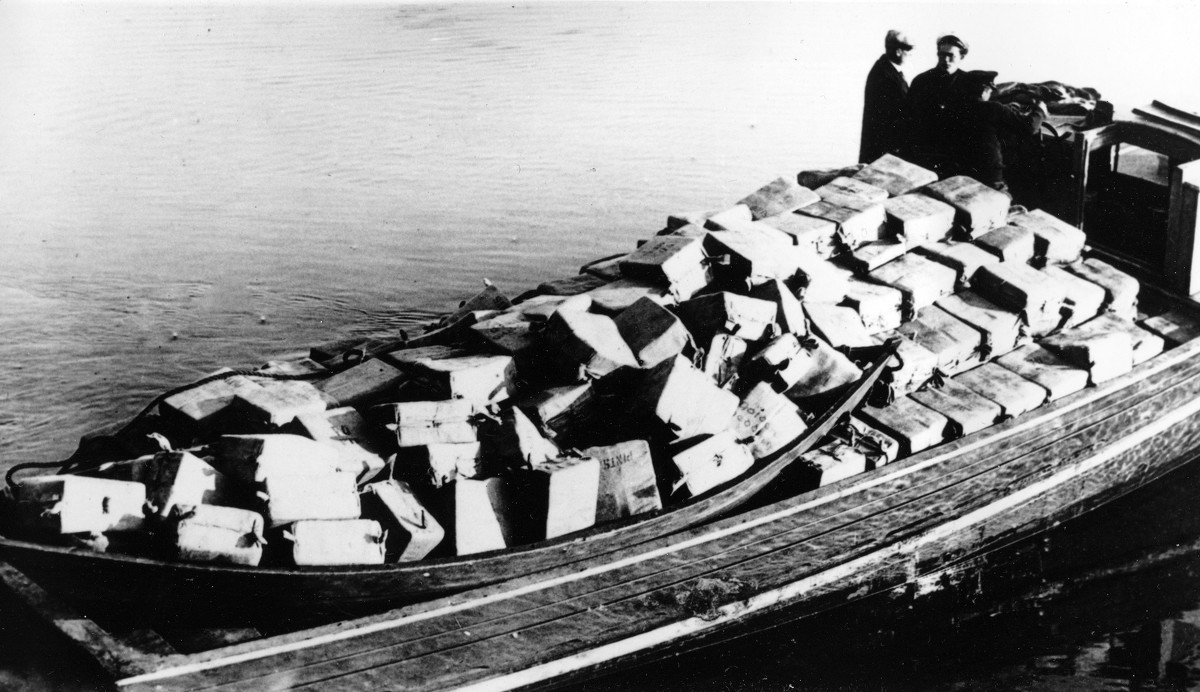
In this May 6, 1932, file photo coast guardsmen stand on a speed boat packed with nearly 700 cases of liquor they captured as it was unloaded at Newburyport, Mass. They pursued the craft from outside the harbor into the Merrimack River. The crew fled as the government boat approached. (AP Photo, File)
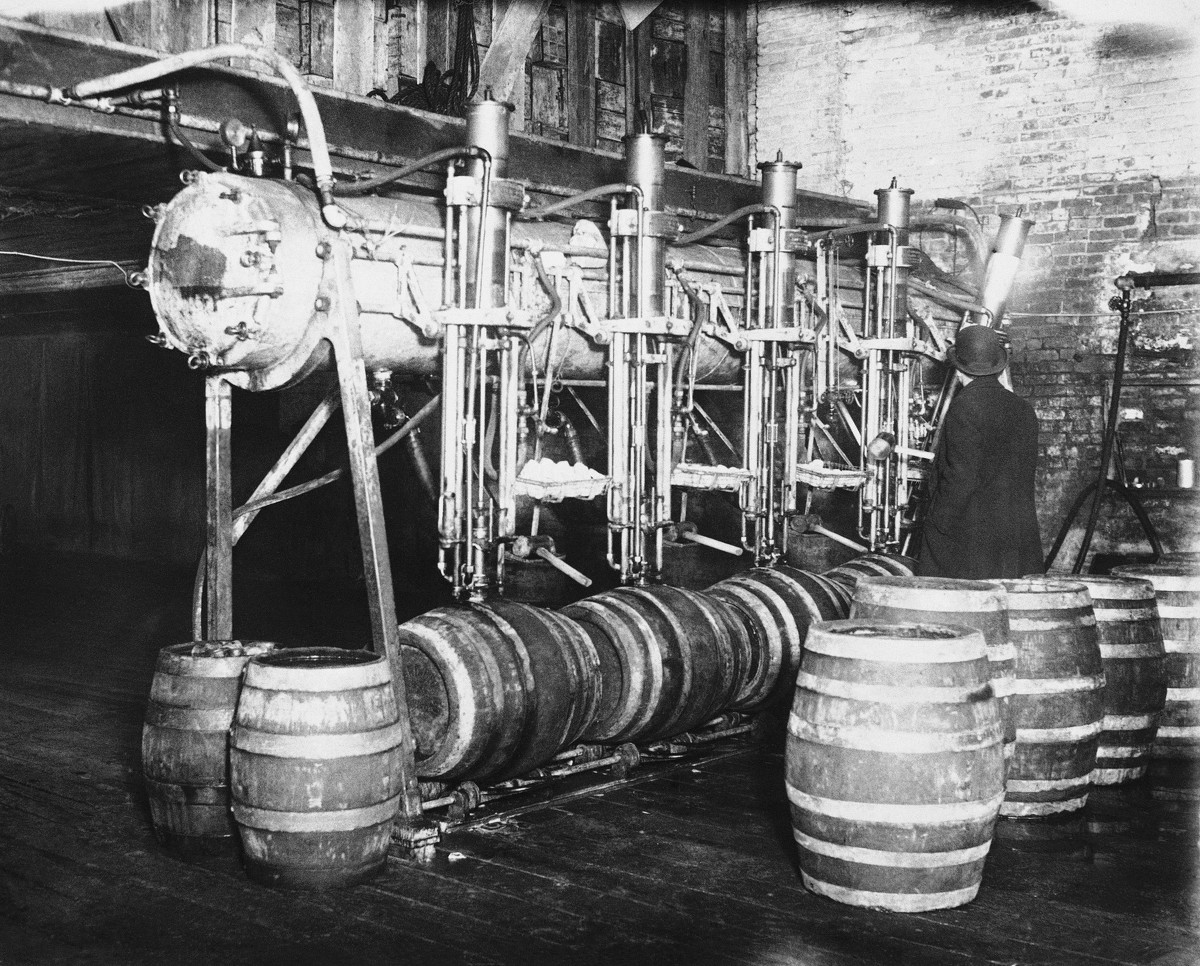
In this March 21, 1931, file photo dry agents seize 7,000 barrels of beer in Newark raid, Calif. Prohibition greatly expanded federal law enforcement powers and turned millions of Americans into scofflaws. It provided a new revenue stream for organized crime. (AP Photo, File)

In this Dec. 27, 2019 photo, Gregory de la Haba serves 20 mugs of beer for a table of customers in McSorley's Old Ale House in New York. Located in Manhattan's Lower East Side, McSorley's opened in the mid-19th century and remained open as a speakeasy during Prohibition. The Prohibition Era, which lasted from Jan. 17, 1920, until December 1933, is now viewed in popular culture as a failed experiment that glamorized pervasive illegal drinking. (AP Photo/Mark Lennihan)
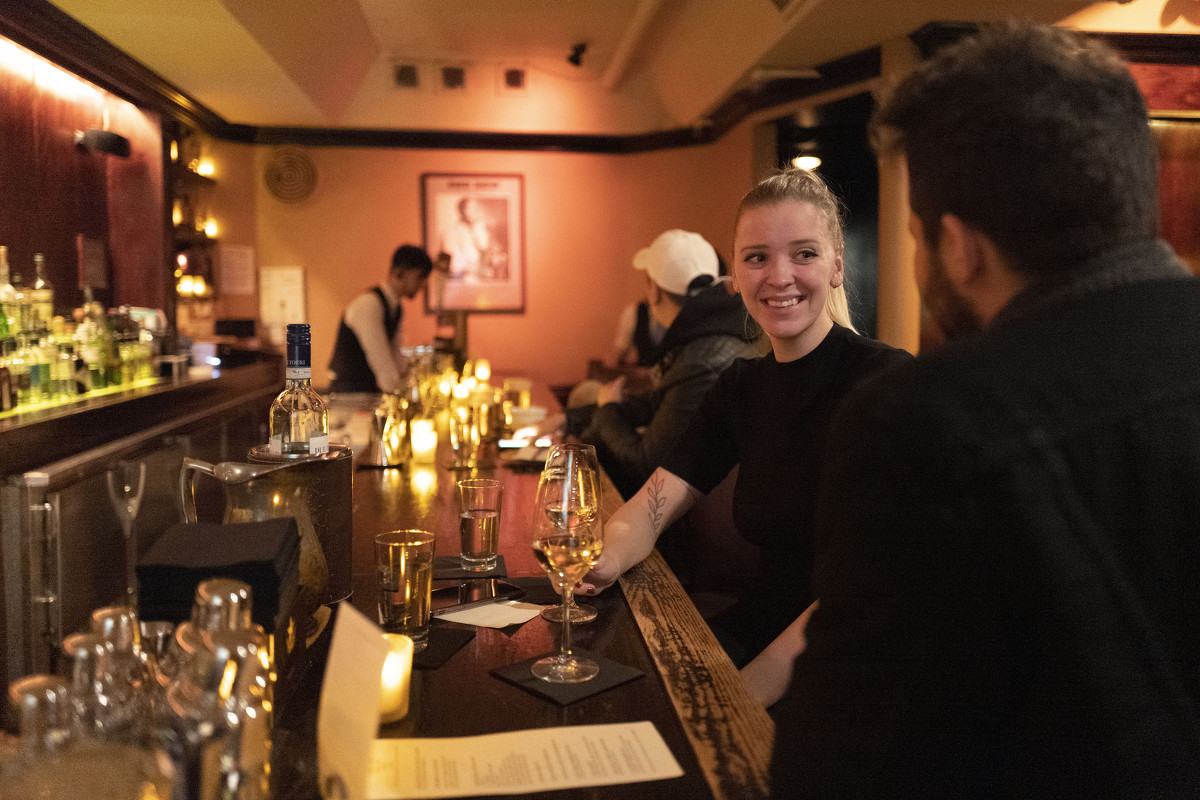
In this Dec. 27, 2019, photo, Ketija Feldmane talks with Alberto Paolino as they sit in B Flat, a Japanese jazz bar in New York. The couple from Milan researched speakeasies before spending a week's vacation in New York. Although not originally a speakeasy, B Flat is a secretive basement bar downstairs from an unmarked street level door in the Tribeca neighborhood. (AP Photo/Mark Lennihan)
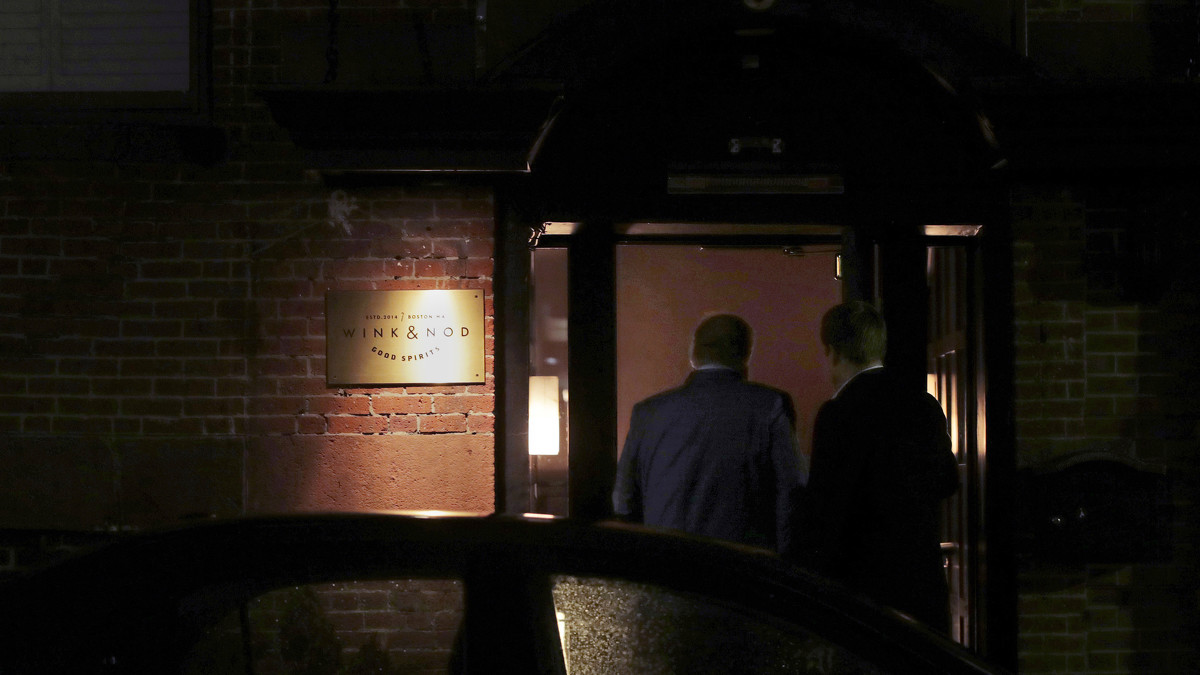
In this Dec. 10, 2019, photo two patrons walk through the barely lit, nondescript doorway leading to the Wink & Nod basement-dwelling, speakeasy-like bar in Boston. Americans are consuming more alcohol per capita now than in the time leading up to Prohibition. (AP Photo/Charles Krupa)